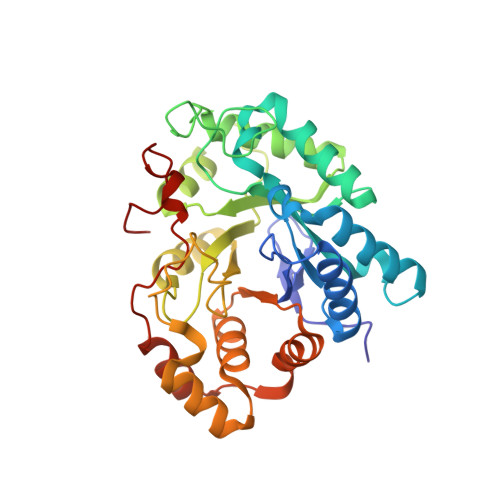Structure of the human 3alpha-hydroxysteroid dehydrogenase type 3 in complex with testosterone and NADP at 1.25-A resolution.
Nahoum, V., Gangloff, A., Legrand, P., Zhu, D.W., Cantin, L., Zhorov, B.S., Luu-The, V., Labrie, F., Breton, R., Lin, S.X.(2001) J Biological Chem 276: 42091-42098
- PubMed: 11514561
- DOI: https://doi.org/10.1074/jbc.M105610200
- Primary Citation of Related Structures:
1J96 - PubMed Abstract:
The first crystallographic structure of human type 3 3alpha-hydroxysteroid dehydrogenase (3alpha-HSD3, AKR1C2), an enzyme playing a critical role in steroid hormone metabolism, has been determined in complex with testosterone and NADP at 1.25-A resolution. The enzyme's 17beta-HSD activity was studied in comparison with its 3alpha-HSD activity. The enzyme catalyzes the inactivation of dihydrotestosterone into 5alpha-androstane-3alpha,17beta-diol (3alpha-diol) as well as the transformation of androstenedione into testosterone. Using our homogeneous and highly active enzyme preparation, we have obtained 150-fold higher 3alpha-HSD specificity as compared with the former reports in the literature. Although the rat and the human 3alpha-HSDs share 81% sequence homology, our structure reveals significantly different geometries of the active sites. Substitution of the Ser(222) by a histidine in the human enzyme may compel the steroid to adopt a different binding to that previously described for the rat (Bennett, M. J., Albert, R. H., Jez, J. M., Ma, H., Penning, T. M., and Lewis, M. (1997) Structure 5, 799-T812). Furthermore, we showed that the affinity for the cofactor is higher in the human 3alpha-HSD3 than the rat enzyme due to the presence of additional hydrogen bonds on the adenine moiety and that the cofactor is present under its reduced form in the active site in our preparation.
Organizational Affiliation:
Oncology and Molecular Endocrinology Research Center, Laval University Medical Center, Qu¨¦bec, Qu¨¦bec G1V 4G2, Canada.



















